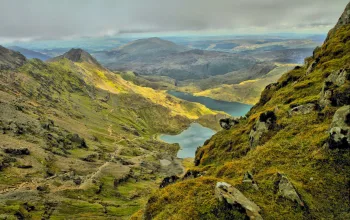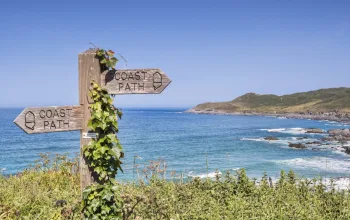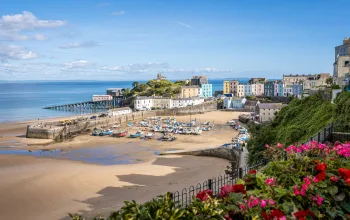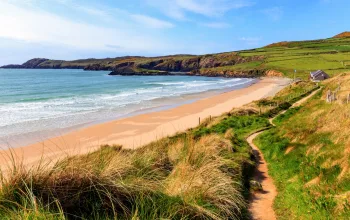On this walk you'll also see one of the best preserved clapper bridges in the country, and follow an ancient lane once used by the tinners and peat cutters, as well as by folk tending their animals on the moor. If you want, you can also visit the Grey Wethers double stone circle, one of the most spectacular on Dartmoor.
The walk starts in the Postbridge car park 1, where there's a useful information centre run by the Dartmoor National Park Authority. The village was formed at the end of the 18th century when a new turnpike road was built; its relative modernity is in sharp contrast to the land around it, which was home to Bronze Age people, as evidenced by hut circles and other prehistoric remains.
You follow a path called Drift Lane, part of an ancient north to south route used by people to get to their animals and activities on the moor. As you come through the gate you can see Hartland Tor to your right. The walk then heads uphill. Eric Hemery in High Dartmoor describes this part of the moor as 'fen', and it can be very boggy in wet weather. In July 2012 we walked up here, and although it was 'summer' it was tough going and several of us got very wet feet!
After you've crossed Braddon Lake 3 - which is actually a stream, as on Dartmoor 'lakes' refer to streams - there is interesting evidence of prehistoric man. As you walk up the hill towards the crest of Broad Down, look to your right down towards the river, and take your mind back 3,000 years, when a group of Bronze Age people set up home here. They lived in round houses with thatched roofs, and the hut circles marked on the map as 'Broadun Ring' are the remains of their homes. It would have been a good spot, sheltered by Broad Down above and with easy access to the river below.
The top of Broad Down is a plateau, with several outcrops known as the Broadun Rocks . It has breathtaking 360 degree views. If you stand and look back the way you came, you can see, left to right, Hay Tor, Rippon Tor and Buckland Beacon. Walk to the end of the plateau, and looking ahead you can see the East Dart below you, with one of the highest peaks on Dartmoor, Cut Hill, over to the left. In 2010 the BBC reported the discovery of a stone row here; it makes you wonder how many more prehistoric sites have yet to be discovered. The place is certainly remote, and you do get a feeling of isolation which you might find chilling or thrilling. The landscape stretches as far as the eye can see and is featureless and fairly devoid of colour, almost like an old sepia photograph.
Once you get to Sandy Hole , the atmosphere changes, and you can feel the presence of man again. There is a ford, and the pool itself is man-made. People used to cut peat here for fuel, and the sides of the pool are dark and earthy. There is silky mud underfoot, great to grab in handfuls and spread on the skin, and the mud also means the water heats up much more quickly here than downstream where the water runs over granite. It is a lovely swim, as the pool is fringed with grasses and reeds, and ponies often graze nearby. You can explore upstream (wet shoes are useful), as there is another, shallower pool about 90 metres further on. In the summer when the foxgloves (old Dartmoor name: cowflops) are out, it is idyllic.
In fact this whole area, despite its remoteness, has been the scene of much human activity over the years. It was mined by medieval tinners, who altered Sandy Hole Pass, a small gorge upstream. They deepened it, to create a conduit to take away the water, and there has been some disagreement among the historians as to why. The general consensus though seems to be that it was to speed up the flow of water, and the resulting deposits of sand further downstream gave rise to the name Sandy Hole. This caused problems in Tudor times though, with complaints from Dartmouth, because all the waste sand that washed down the river silted up the harbour.
After a dip and explore at Sandy Hole, the next stop is the East Dart Waterfall , a veritable beauty spot with an unusual curtain of water falling diagonally down a seven foot drop, and then rushing over a series of large ledges to a pool below. William Crossing, in his 1888 guide to walks on Dartmoor, Amid Devonia's Alps describes it as a "charming cascade". If there's enough water, you can swoosh down into the pool.
The walk continues by crossing the waterfall (it is best viewed from the northern side), and following the course of the river back to Postbridge. You will notice how the river forms a sharp right angle just after a small island; this is not natural but was formed by people 'streaming' for tin. The early tin miners would extract tin gravel deposits from the rivers, in a process involving digging trenches so they could 'stream' water over the tin and separate it out from the other minerals. Don't miss the Beehive Hut a little further on; it looks like an igloo without a roof. Bees were never kept here; it is so-called because of its resemblance to a traditional straw beehive. It was actually built by tinners to store their tools and as a shelter, or perhaps even as a place to stay overnight when out working.
At this point you can do a detour, following the footpath directly north to the stunning Grey Wethers double stone circle. Chris Collier, the author of the respected Stone Circles website (stone-circles.org.uk), has this to say about it: "The question as to why there are two circles here remains unanswered, could the fact that they stand on an almost north-south axis be important, or was it that the two valleys on either side marked an ancient trackway or trade route with each valley belonging to a separate family or tribal group? Did they form the separate meeting place for men and women before some kind of wedding ceremony, perhaps on Sittaford Tor, or were they a place where the recently deceased passed from the land of the living in one circle to the realm of the ancestors in the other? This is a site that poses many more questions than it answers."
Back on the main walk, as you continue along the contours of the hillside you will see a brilliantly well-defined stone wall circle ahead on the other side of the river. This is Roundy Park, the site of a Bronze Age village. The wall would have enclosed their settlement, but has probably been added to over the years by farmers who used it to enclose their livestock. There is a large and well-preserved kistvaen, or burial tomb there, which was first recorded at the end of the 19th century.
As the walk nears its end you get to Hartland Tor - the only tor on this walk. Apparently there is a hidden memorial to a man from Liverpool, William Donaghy, who died there in a blizzard in 1914. Eric Hemery, in High Dartmoor, reports that it is low on the west-south-west slope of the tor, overhung by gorse. We couldn't find it but maybe you can!
When you get back to Postbridge, stop to admire the ancient clapper bridge, thought to have been built in the 13th century. It is one of the finest examples in the country, made of huge slabs of granite, created to enable pack horses carrying tin to cross.
Sandy Hole and East Dart Waterfall Circular wild swimming walk directions
1 Take the path to the left of the Visitor Centre in the car park. Cross the stream, go through the gate and follow the path with the dry stone wall on your right. 0.4 miles
2 The path then heads in a north westerly direction away from the wall; follow it to a little stream called Braddon Lake. 0.4 miles
3 Cross Braddon Lake, go through the stile and walk with the wall on your right. As you go up the hill, the path bends away from the wall towards a stile at the top of the hill. Cross the stile over the stone wall. 0.1 miles
4 Keep walking until you get to a plateau with two rocky outcrops. You will see the East Dart River ahead. 0.5 miles
5 Head west, walking along the contours of the hill; you will see the waterfall below on your right, but don't go there (yet). Keep walking and you will see the rocky gorge of Sandy Hole Pass ahead. The pool is before the pass - you can't miss it, it's big and round. 0.8 miles
6 Swim here, before heading back along the river to the waterfall where you can have another dip. 0.1 miles
7 Cross the waterfall to head back along the northern side of the river. Follow the path above the river, with the river on your right.
0.5 miles
8 You cross a stream - Winney's Down Brook - and pass an island on your right. 0.2 miles
9 Cross another stream, and stop to look at the Beehive hut, about 45 metres to your left after crossing the stream. 0.1 miles (At this point you can do a diversion to visit the Grey Wethers double stone circle. From the Beehive hut, walk a mile north on the bridleway to see the circles, and then retrace your steps to the Beehive.)
10 From the Beehive, follow the path south with the river on your right, past Hartland Tor on your left and down through the wood by the river, and back to Postbridge. 1.7 miles
Route reproduced with kind permission from Wild Swimming Walks, book available now for only £14.99 from wildthingspublishing.com






















